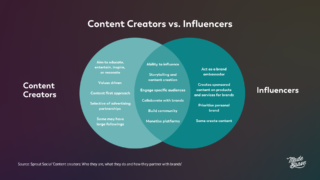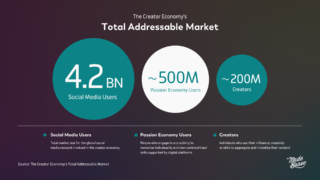While scrolling through your social media feed these days, you’ve probably noticed more and more content from people, rather than from big brands. Content creators are catching our attention every day, making us laugh, think, or even answer those deep-burning questions we have. This shift is more than just a trend; it’s the power of the creator economy in action.
What is the Creator Economy?
The creator economy is a new economic model where individuals—known as ‘creators’—produce and monetise their own content, services, or products. These creators reach their audience directly through digital platforms, sidestepping the need for publishers and advertisers. According to Goldman Sachs, the creator economy is valued at $250 billion in 2023 and is projected to nearly double by 2027.

This new economic landscape has four main players: the creators who produce the content, the platforms that host it, the brands that sponsor or promote it, and the consumers or fans who engage with it.
The rise of social media and the increasing amount of time we spend online has accelerated this growth, offering creators different ways to earn—from advertising and sponsorships to donations, subscriptions, and even selling their own products. We covered this in-depth during our first-ever meet-up for content creators—the CreatorMashup.
Content Creators vs. Influencers: What’s the Difference?
The labels ‘content creators’ and ‘influencers’ are often mistakenly used as if they mean the same thing. Some influencers HATE being called as such (even if they are), preferring to be called content creators. It is very much open to interpretation. As GWI highlights, the distinction is all about their underlying intention. This is important for brands to note when considering partnerships.
Influencers focus on promoting products or services, often in partnership with brands. Content creators, on the other hand, aim to provide valuable content that resonates with their audience. They may monetise their content through means like advertising, but their main goal is to create content that their audience finds valuable.
In general, content creators are more focused on creating high-quality content that help educate, entertain, inspire or evoke emotion while influencers are more focused on their personal brand by promoting products or services. However, there is some overlap between the two. Some content creators also have a large following on social media, and some influencers also create their own content.

The New Influencers: Meet the Culture Creators
Content creators are redefining what it means to be an influencer. Their content is usually more aligned with their personality and interests, making their endorsements more credible and their audience engagement more organic.
They are often perceived as more authentic and trustworthy than traditional influencers, which has significant implications for brands. According to GWI, 17% of fans subscribe to their favourite creators, and 14% even tip them. This opens new revenue streams for brands, such as paid subscriptions or tipping options.
The shift towards authenticity has led to a more sustainable income for creators. In response, some brands are now hiring their own in-house content creators and offering affiliate marketing programmes to earn additional revenue. This not only diversifies revenue for creators but also helps brands reach customers who are sceptical of traditional advertising.
Who’s Driving the Creator Economy?
Contrary to popular belief, the creator economy isn’t just a playground for the Gen Z or the tech-savvy. A HubSpot report found that 30% of 18 to 24-year-olds consider themselves content creators, but so do 40% of 25 to 34-year-olds. This indicates that the creator economy’s impact spans across age groups, making it a versatile and powerful medium for brands to explore.

More and more people are identifying as content creators. The creator economy is global, with creators and fans spread across many different countries and cultures. This international reach offers brands an opportunity to tap into diverse markets without the high costs typically associated with global advertising campaigns. Around 200 million people now consider themselves creators and a little more than a third consider it their full-time career.

What Brands Should Consider When Working with Content Creators
Working with content creators and influencers have different processes, each with their own results and objectives. Here’s a straightforward look at when to consider a Content Creator for your brand:
- To enhance your branded content by going beyond your in-house team by adding more diverse content from creators
- To engage audiences with more short attention spans more effectively, by transitioning away from traditional and digital ads
- With a tight budget, using content creators to supplement or even replace paid media by tapping into their audiences
- When your brand needs a high-quality, professional branded content piece
- When you want to embrace a content creator’s distinctive style for a fresh representation of your brand
- For one-time projects, think about collaborating with content creators rather than hiring freelancers or contractors
Pros for Brands
Direct reach
Even if content creators have smaller audiences than mainstream influencers, they offer a direct channel to potential fans. Brands can access niche, engaged audiences who trust and value the creator’s recommendations.
Diverse skill set
Content creators have a mix of creative skills, like art direction, styling, photography, copywriting, and video production. This means they can provide brands with a complete content package cost-effectively.
Tailored branded content
Brands can receive content that aligns perfectly with their messaging and branding guidelines.
Storytelling expertise
With their knack for content marketing, digital creators can deliver compelling stories around a brand, which can enhance campaign effectiveness.
More cost-effective
Content creators typically have smaller targeted audiences and charge lower fees than influencers. This can save brands money on marketing campaigns.
Potential Cons for Brands
Operational demands
Finding the right content creators, briefing them on brand values, reviewing content, and assessing impact can be time-consuming and complex.
Fixed processes
Certain creators follow set processes and might not be very adaptable when it comes to customising content to meet specific brand needs.
Limited sponsored content
Many shy away from overtly promotional content such as sponsored content, which might not align with brands looking for direct advertorial content. It’s essential to align content expectations from the outset.
Limited reach
It’s worth noting that a significant online presence doesn’t always translate to influence. Some creators, despite producing quality content, might not guarantee extensive reach or impressions.
Not a silver bullet
Despite the hype, content creators are not a standalone solution. It should be viewed as a part of a wider brand and communications strategy.
Wrapping it up
The creator economy is here to stay, with brands expected to spend up to $7 billion on influencer marketing by 2024. Brands looking to collaborate with content creators should approach content creator opportunities with a clear understanding of shared values and individual differences. By doing so, they can build successful collaborations that can effectively resonate with their target audience.
The creator economy is reshaping the way brands think about marketing and audience engagement. By understanding the needs and preferences of content creators, brands can build more authentic and effective marketing campaigns.



